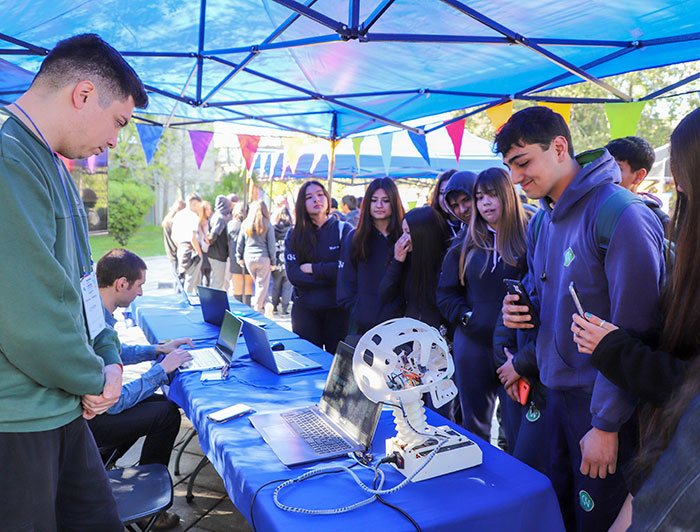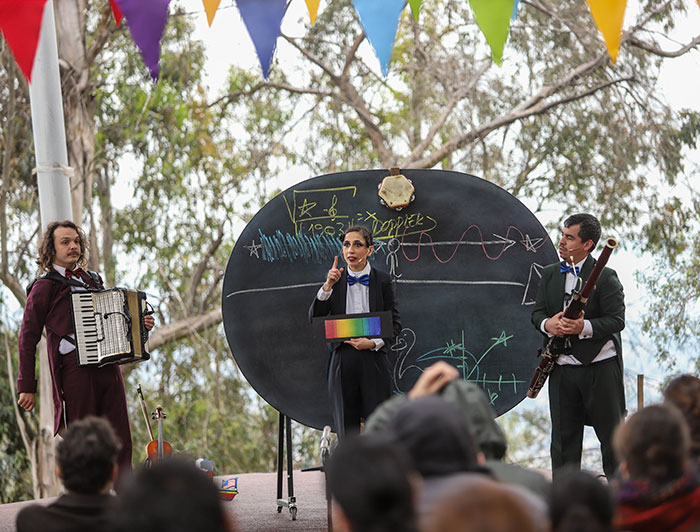Science in everyday activities, science on the street, science on the faces of children and adults, and in its ability to surprise people. More than 10 thousand people who lived Science Festival In Santiago.
This science festival is held under the leadership of Ministry of Science, Technology, Knowledge and Innovation (CTCI) Co-run by Catholic University during the week of October 1 to 8.
The meeting began Mount San CristobalThen proceed La Pintana, Renca, Lo Farnesia, UC San Joaquin Campus and Maibu. Within the framework of this festival students from different schools, neighbors, seniors and all institutions related to the activities promoted by the university came to these communes and they were part of the scientific dissemination in different areas.
“It’s great that science is in a public space and free, because like butterflies we can all learn more and solve our doubts about what we want.”declared Maria Chavez On Sunday, October 8, he toured the more than 30 stands located in the Plaza de Maipu with his mother.
Through the generations, The Science Festival sought to unite art and science through chemical reactions with salt crystals, imitating the shapes and colors of rocks on the coast of Chile, and Foster, Cero’s observational “Dubahu” play.In 1903, the achievement of establishing an observatory of the world’s southern sky atop Cerro San Cristóbal was playfully illustrated.
“There were thousands of people across the country who enjoyed science and knowledge in various forms. At the Plaza de Maipú, we marveled at more than 30 stands, a play, workshops, astronomy. For the first time, we are reaching out to all regions with such activities,” he said CTCI Ministry Deputy Secretary, Carolina Keynza. “We were able to do more than 200 activities to invite people of all ages to discover the science and knowledge in each of them, in everything around us.”Deputy Secretary added.
In terms of Center for Cultural and Indigenous Studies – CIIR, participants were able to learn about the names of the stars in Mapuzungún through memorization. A few meters further, at the stand National Center for Artificial Intelligence – CENIA, a robot -Fiona- answered any question through artificial intelligence. During the tour, status Chilean Mathematical Society (Somachi), in which people were challenged to fun games that taught, for example, the Pythagorean Theorem. Also, the stand will attract the attention of children and adults alike Duke UC It featured a robot dog that played “dead” by waving its paw at the audience.
The two-day celebration at Plaza Maibu began with a presentation by the group “The Phi” -Their percussion and musical performance, using instruments built from materials considered to be waste, trash cans and boxes, amazed people of all ages, especially “Music has scientific patterns and beats, and everyone can create using it. The elements at hand let creativity fly.”
Dream about science
In the packed Municipal Theater of Maipu, an eight-year-old girl raises her hand and confidently and confidently asks the panel: “What is the probability that I will be an astronomer? “
That was the situation after the drama exhibition “Foster, The Cerro Dupahoo Laboratory”While part of the company Trio Theater Band Montage’s editors-, along with the responsible scientist, UC’s engineering professor Leonardo Vanci, spoke with the host of the day and took questions from the participants.
As UC Vice-Rector for Research, Pedro Bouchon, revealed, “We hope that everyone can get infected from these places and really engage with science, so they can experience those interactions in the classroom in a different way, seeing the science around them.”.
But not only women, children and adolescents were able to participate in the activities that took place in various communities in the province of Santiago; Older people also actively participated, for example, in Workshop “Photography of Superflat Crystals, Art or Science?” from UC Faculty of Chemistry and Pharmacology. “I have worked in education for many years, and before that, science was promoted from children to all students. It has been lost, and today, as an adult, one believes that nothing new can be learned, and it surprises you again, because it is something you did not know.He said in the middle of a conversation with the workshop participants. Julia VillarA neighbor of La Pintana.
Being an artist and a part of science at the same time is one of the main motivations promoted by the Science Festival. In its fifth edition, the festival marked its presence with more than 200 free activities across the country.
“For us, it gives us pleasure to end a week with a great science festival in a place like the Institute,” Vice-Rector Pedro Buchan noted. “The work with communities, municipalities and ministries, intertwined with what the Catholic University has created, has allowed us to have this interesting scene that includes different dimensions of knowledge, and it has allowed us to reach different age groups.”.
I also analyzed Alopes distanceParticipating in activities, who He was grateful for events like this “because they allow whole families to come.” It’s always very good, because everything is quiet and even if there are people who think that people will not participate in these activities, the proof is here,” he pointed to the place where his granddaughter and daughter learned more details about the human body. , in terms of Millennium Institute for Engineering and Artificial Intelligence for Health (iHEALTH).

Mario Ponce, academician at the UC Faculty of Mathematics and director of the Science Festival for the Province of Santiago, announced in his presentation to the public that he could read minds. Everyone looked at him in surprise and disbelief, and at that moment, between jokes, the teacher explained that through math exercises, he had “guessed” a number that someone had chosen at random. “The wonderful thing about science is that it permeates so many things that we do every day, and that it inspires us to wonder, to doubt, to question, and to seek solutions to those questions.”The audience applauded at the end of the day, Ponce said.
While girls and boys tested what they learned on the stand to win popular science books, others understood how aerodynamics worked and put together paper airplanes. At the same time, many adults marveled at his work “Drummers, Weaving Rocks”Initiative arrangement NUTME Millennium Nucleus And this Faculty of Mathematicswith support Directorate of Research, from the Office of the UC Vice Chancellor for Research. This year in March and April the exhibition featured rocks and marine species from the coast of Chile crocheted by elderly people from El Tapo and El Quisco, Valparaíso region. During the festival, elders from various communities learned to make these works in workshops located in Renka, Lo Farnesia and Maibu. This festive mood and discovery was maintained for two full days in the Plaza de Maipu, where a large science festival was held.
Bring knowledge closer to regions

“Bugs, that’s what I love the most! -indicates the sample Center for Applied Ecology and Sustainability – Capes– And, on another level, I made a heart and learned new parts of the brain, but I liked bugs the most,” he said. Mathias RomeroEleven years old, after touring the big science fair.
“We are very happy with this initiative of the Ministry of Science and the Catholic University, which allows us to be in the Plaza de Maipu today, because on the one hand, we can move forward in the restoration of this public space. Important for us is the complementing of social activity, sports, culture and, in this case, science,” said Mayor of Maipú Tomás Vodanovic In his inaugural address. He also commented “It is important to bring knowledge closer, it is important to democratize its access to all our neighbors, and it is very gratifying to see the presence of so much science, but above all the children, women, elderly and many Maibuquina families “this place to give life to this wonderful festival”.
Two successful days created by the team of the Knowledge Communication Unit of the UC Vice-Chancellor’s Office for Research, where all the directorates of this Vice-Chancellor’s Office come together to promote, sustain and massify environmental questioning scenarios surround us. “We feel very happy and proud to be able to organize the science festival in the province of Santiago. We tried to reach different points in such a wide and diverse territory, doing about twenty activities in squares, theaters, high schools, community headquarters and the top of San Cristóbal Hill. In the process, we met many people in the area, built relationships with companies and built a team” he commented Elliot AngelCo-ordinator of the Knowledge Communication Unit of the Vice-Chancellor for Research.
From the beginning, the CTCI Ministry’s deep quest was to prove precisely that: science is not as far-fetched as many think, but revealed in the most everyday things. Minister Ison Etchevery In his various interviews across the country. “Ever since we woke up, we’ve lived with science and technology: the breakfast we eat, the subway we use to get around town, etc. That’s why, We have a firm commitment from the government to make science and technology pillars in the construction of public policies To give more power to everything we do, the same goes for citizens, allowing them to understand how their curiosity can improve us and how science is not just what happens in labs, but our everyday lives. Every time we ask ourselves a question.”

